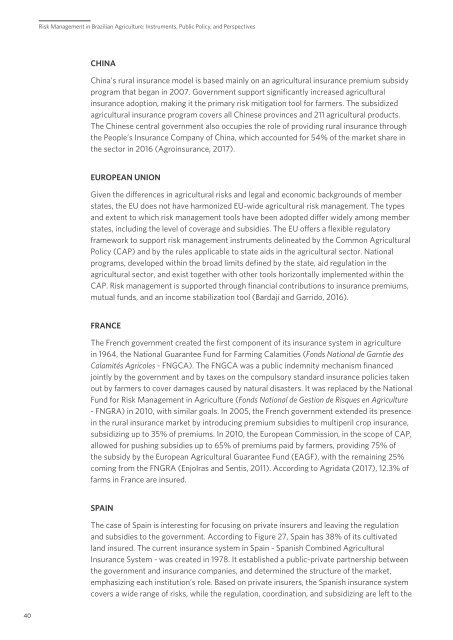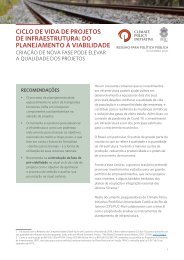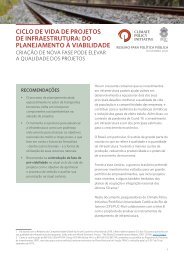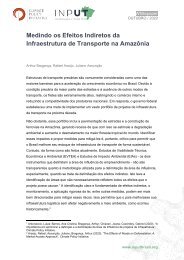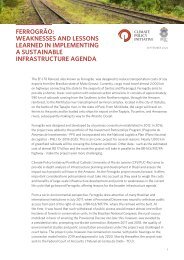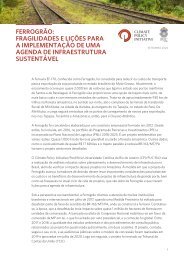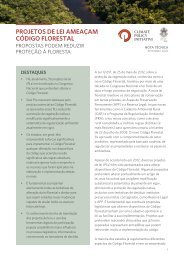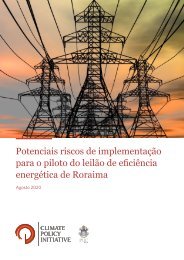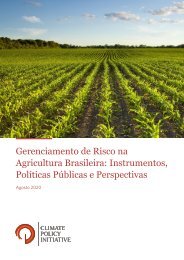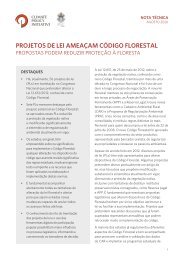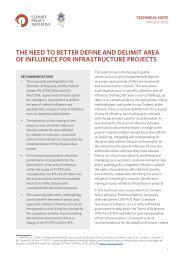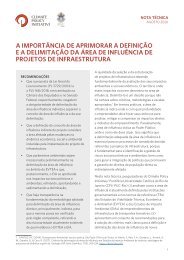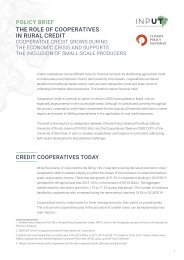Report - Risk Management in Brazilian Agriculture
You also want an ePaper? Increase the reach of your titles
YUMPU automatically turns print PDFs into web optimized ePapers that Google loves.
<strong>Risk</strong> <strong>Management</strong> <strong>in</strong> <strong>Brazilian</strong> <strong>Agriculture</strong>: Instruments, Public Policy, and Perspectives<br />
CHINA<br />
Ch<strong>in</strong>a’s rural <strong>in</strong>surance model is based ma<strong>in</strong>ly on an agricultural <strong>in</strong>surance premium subsidy<br />
program that began <strong>in</strong> 2007. Government support significantly <strong>in</strong>creased agricultural<br />
<strong>in</strong>surance adoption, mak<strong>in</strong>g it the primary risk mitigation tool for farmers. The subsidized<br />
agricultural <strong>in</strong>surance program covers all Ch<strong>in</strong>ese prov<strong>in</strong>ces and 211 agricultural products.<br />
The Ch<strong>in</strong>ese central government also occupies the role of provid<strong>in</strong>g rural <strong>in</strong>surance through<br />
the People’s Insurance Company of Ch<strong>in</strong>a, which accounted for 54% of the market share <strong>in</strong><br />
the sector <strong>in</strong> 2016 (Agro<strong>in</strong>surance, 2017).<br />
EUROPEAN UNION<br />
Given the differences <strong>in</strong> agricultural risks and legal and economic backgrounds of member<br />
states, the EU does not have harmonized EU-wide agricultural risk management. The types<br />
and extent to which risk management tools have been adopted differ widely among member<br />
states, <strong>in</strong>clud<strong>in</strong>g the level of coverage and subsidies. The EU offers a flexible regulatory<br />
framework to support risk management <strong>in</strong>struments del<strong>in</strong>eated by the Common Agricultural<br />
Policy (CAP) and by the rules applicable to state aids <strong>in</strong> the agricultural sector. National<br />
programs, developed with<strong>in</strong> the broad limits def<strong>in</strong>ed by the state, aid regulation <strong>in</strong> the<br />
agricultural sector, and exist together with other tools horizontally implemented with<strong>in</strong> the<br />
CAP. <strong>Risk</strong> management is supported through f<strong>in</strong>ancial contributions to <strong>in</strong>surance premiums,<br />
mutual funds, and an <strong>in</strong>come stabilization tool (Bardají and Garrido, 2016).<br />
FRANCE<br />
The French government created the first component of its <strong>in</strong>surance system <strong>in</strong> agriculture<br />
<strong>in</strong> 1964, the National Guarantee Fund for Farm<strong>in</strong>g Calamities (Fonds National de Garntie des<br />
Calamités Agricoles - FNGCA). The FNGCA was a public <strong>in</strong>demnity mechanism f<strong>in</strong>anced<br />
jo<strong>in</strong>tly by the government and by taxes on the compulsory standard <strong>in</strong>surance policies taken<br />
out by farmers to cover damages caused by natural disasters. It was replaced by the National<br />
Fund for <strong>Risk</strong> <strong>Management</strong> <strong>in</strong> <strong>Agriculture</strong> (Fonds National de Gestion de Risques en <strong>Agriculture</strong><br />
- FNGRA) <strong>in</strong> 2010, with similar goals. In 2005, the French government extended its presence<br />
<strong>in</strong> the rural <strong>in</strong>surance market by <strong>in</strong>troduc<strong>in</strong>g premium subsidies to multiperil crop <strong>in</strong>surance,<br />
subsidiz<strong>in</strong>g up to 35% of premiums. In 2010, the European Commission, <strong>in</strong> the scope of CAP,<br />
allowed for push<strong>in</strong>g subsidies up to 65% of premiums paid by farmers, provid<strong>in</strong>g 75% of<br />
the subsidy by the European Agricultural Guarantee Fund (EAGF), with the rema<strong>in</strong><strong>in</strong>g 25%<br />
com<strong>in</strong>g from the FNGRA (Enjolras and Sentis, 2011). Accord<strong>in</strong>g to Agridata (2017), 12.3% of<br />
farms <strong>in</strong> France are <strong>in</strong>sured.<br />
SPAIN<br />
The case of Spa<strong>in</strong> is <strong>in</strong>terest<strong>in</strong>g for focus<strong>in</strong>g on private <strong>in</strong>surers and leav<strong>in</strong>g the regulation<br />
and subsidies to the government. Accord<strong>in</strong>g to Figure 27, Spa<strong>in</strong> has 38% of its cultivated<br />
land <strong>in</strong>sured. The current <strong>in</strong>surance system <strong>in</strong> Spa<strong>in</strong> - Spanish Comb<strong>in</strong>ed Agricultural<br />
Insurance System - was created <strong>in</strong> 1978. It established a public-private partnership between<br />
the government and <strong>in</strong>surance companies, and determ<strong>in</strong>ed the structure of the market,<br />
emphasiz<strong>in</strong>g each <strong>in</strong>stitution’s role. Based on private <strong>in</strong>surers, the Spanish <strong>in</strong>surance system<br />
covers a wide range of risks, while the regulation, coord<strong>in</strong>ation, and subsidiz<strong>in</strong>g are left to the<br />
40


